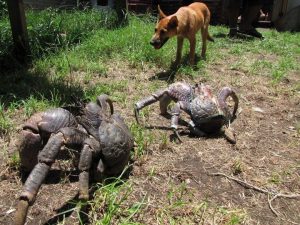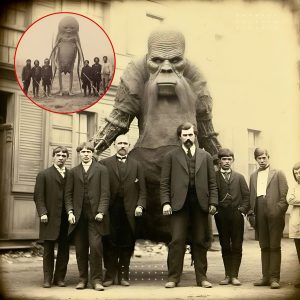Coconut Crabs: Nature’s Giant Land Arthropods with a Fascinating Lifestyle

Introduction
Coconut crabs are an awe-inspiring sight. As the largest land-dwelling arthropods on Earth, they have earned their place in the world of nature’s marvels. Often mistaken for creatures from a sci-fi movie, these crabs are more than just their intimidating size. Let’s explore what makes them unique, from their coconut-cracking skills to their evolution as terrestrial beings.
The World’s Largest Land-Based Arthropod
Coconut crabs (Birgus latro) hold the title as the world’s largest land-based arthropod. When fully grown, these crabs can weigh up to 9 pounds (4 kg) and have a leg span of up to three feet (1 meter), often reaching a size comparable to that of a domestic cat. With their blue or reddish-brown armored bodies and massive claws, they may appear formidable, but they are surprisingly gentle creatures.
The Name Behind the Crab
The name “coconut crab” comes from their favorite snack—the coconut. These crabs are known for their impressive ability to climb coconut trees, using their powerful claws to pluck coconuts from the top. Once on the ground, the crabs display their strength, cracking open the coconuts to get to the nutritious meat inside. This behavior is not only remarkable but also a testament to their incredible physical strength, making them well-adapted to their island environments.
Adapted to Land
One of the most fascinating aspects of coconut crabs is their adaptation to life on land. Unlike many other crab species, coconut crabs have evolved to breathe exclusively on land through a unique organ known as the branchiostegal lung. This adaptation allows them to thrive in their terrestrial habitats, which include coastal forests and islands across the Indian and Pacific Oceans. Unlike their aquatic relatives, placing a coconut crab in water can be fatal, as they cannot breathe underwater.
A Gentle Giant
Despite their daunting appearance, coconut crabs are not aggressive towards humans. Their diet mainly consists of fruits, nuts, seeds, and carrion, with a particular love for coconuts. They use their massive claws to break open hard-shelled fruits, which also serve as tools for defense if threatened. However, coconut crabs are generally docile and prefer to keep to themselves, only using their claws when they feel directly endangered.
Their Behavior: Climbers of the Canopy
In addition to their coconut-cracking abilities, coconut crabs are skilled climbers. They can effortlessly scale tall trees and even vertical walls, often resting during the day hidden among tree branches or within rock crevices. Their climbing abilities add to their somewhat eerie, spider-like appearance, especially when they are seen scaling walls under the cover of darkness.
Threats and Conservation
While coconut crabs are known to be long-lived creatures, often surviving for over 60 years, they face threats from habitat loss, human hunting, and vehicle traffic. In some areas, their populations have dwindled due to overharvesting for food. As fascinating as they are, coconut crabs are still vulnerable, and conservation efforts are essential to protect these unique creatures and the delicate ecosystems they inhabit.
Conclusion
Coconut crabs are truly remarkable beings, with adaptations that allow them to thrive on land in a way few other crabs can. They are a blend of strength, unique behavior, and evolutionary marvels that make them one of nature’s most interesting land-dwelling animals. Despite their fearsome looks, they are gentle giants of the islands, contributing to their environment in quiet but impactful ways. As we learn more about them, it becomes clear that these crabs deserve both our admiration and our protection.
This article will provide readers with a rich understanding of coconut crabs, covering their biology, behavior, and role in their habitat while emphasizing the need for conservation.





